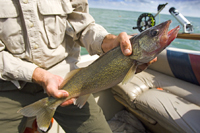FLORENCE, Wis. — A cooperative project by Wisconsin and Michigan fisheries managers aims to collect population and breeding data on an important native strain of walleye while providing fingerlings uniquely suited for a regional stocking effort.
Mike Vogelsang, north district fisheries supervisor for the Wisconsin Department of Natural Resources, said the research is taking place on the Brule River, which is home to a relatively pure strain of Lake Michigan walleye. The river meanders to separate Wisconsin’s Florence and Forest counties from Michigan’s Iron County before it eventually reaches the Menominee River and flows into Lake Michigan.
The river features more than 27 miles of cold class I trout waters and its impoundment areas serve as the perfect home to a strain of Lake Michigan walleye that has been largely unaffected by the hybridization seen in other waters following a variety of stocking efforts over the years.
“These fish are the best example of Lake Michigan strain walleye in the area,” Vogelsang said. “This is really a science-based way to approach stocking in that you want to find a source of fish that is native to a drainage basin. This walleye strain has evolved over time to be in these waters, so it is best suited for the area genetically.”
The main focus of the cooperative research involves an assessment of the age structure and health of walleye in the area. Thanks to access granted by Michigan fisheries staff, Wisconsin team members from the Florence field office and the Art Oehmcke Hatchery will place nets in more than a dozen locations in the waters of both states in the days ahead.
Walleye captured in the nets will be measured and weighed and a scale sample will be taken to determine age. Fish that are ready to spawn will contribute eggs and milt with a goal of harvesting some 1.7 million eggs.
Given that each adult female walleye carries on average about 70,000 to 80,000 eggs, the team hopes to come up with about 20 to 30 ripe females and at least as many males. After all the fish have been weighed and processed, they will be returned to the river.
“The strong working relationship that has developed between our states and in particular, our fisheries teams, makes this type of cooperative research possible,’’ said Darren Kramer, Northern Lake Michigan Unit manager with the Michigan Department of Natural Resources. “We anticipate gaining valuable insights from this work that will help inform our efforts in the jointly managed fishery going forward.”
In addition to assessing the overall health of the walleye population, the research effort also will involve northern pike, bass and panfish — other popular targets of recreational anglers in the region.
Vogelsang said the walleye egg collection effort is expected to produce approximately 30,000 fish for stocking in Forest and Florence counties as part of the Wisconsin Walleye Initiative. The fish will be reared at the Oehmcke facility in Woodruff and will be stocked as 5 to 6 inch extended growth fingerlings in September.
“We appreciate the support of the Michigan fisheries team and have seen benefits to both states from past efforts involving musky stocking, genetics work and other research,” Vogelsang said. “The more we learn, the better we are able to implement best practices in maintaining healthy fish populations in our border waters.”
To learn more about walleye stocking efforts, visit dnr.wi.gov and search “Wisconsin Walleye Initiative.” More information about Michigan’s fisheries management efforts can be found by visiting Michigan.gov/dnr and searching for “Walleye Better Fishing Waters.”
No comments:
Post a Comment